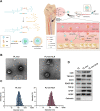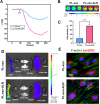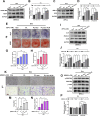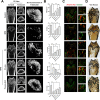Bone-targeting delivery of platelet lysate exosomes ameliorates glucocorticoid-induced osteoporosis by enhancing bone-vessel coupling
- PMID: 36310171
- PMCID: PMC9620632
- DOI: 10.1186/s12951-022-01400-1
Bone-targeting delivery of platelet lysate exosomes ameliorates glucocorticoid-induced osteoporosis by enhancing bone-vessel coupling
Abstract
Background: Glucocorticoids (GCs) overuse is associated with decreased bone mass and osseous vasculature destruction, leading to severe osteoporosis. Platelet lysates (PL) as a pool of growth factors (GFs) were widely used in local bone repair by its potent pro-regeneration and pro-angiogenesis. However, it is still seldom applied for treating systemic osteopathia due to the lack of a suitable delivery strategy. The non-targeted distribution of GFs might cause tumorigenesis in other organs.
Results: In this study, PL-derived exosomes (PL-exo) were isolated to enrich the platelet-derived GFs, followed by conjugating with alendronate (ALN) grafted PEGylated phospholipid (DSPE-PEG-ALN) to establish a bone-targeting PL-exo (PL-exo-ALN). The in vitro hydroxyapatite binding affinity and in vivo bone targeting aggregation of PL-exo were significantly enhanced after ALN modification. Besides directly modulating the osteogenic and angiogenic differentiation of bone marrow mesenchymal stem cells (BMSCs) and endothelial progenitor cells (EPCs), respectively, PL-exo-ALN also facilitate their coupling under GCs' stimulation. Additionally, intravenous injection of PL-exo-ALN could successfully rescue GCs induced osteoporosis (GIOP) in vivo.
Conclusions: PL-exo-ALN may be utilized as a novel nanoplatform for precise infusion of GFs to bone sites and exerts promising therapeutic potential for GIOP.
Keywords: Bone-targeting; Exosome; Glucocorticoid; Osteoporosis; Platelet lysate.
© 2022. The Author(s).
Conflict of interest statement
The authors declare no conflict of interest.
Figures








References
-
- Rentero ML, Amigo E, Chozas N, Prada MF, Silva-Fernández L, Hernandez MAA, Barrera JMR, del Pino-Montes J. Prevalence of fractures in women with rheumatoid arthritis and/or systemic lupus erythematosus on chronic glucocorticoid therapy. BMC Musculoskelet Disord. 2015;16:1–10. doi: 10.1186/s12891-015-0733-9. - DOI - PMC - PubMed
MeSH terms
Substances
Grants and funding
LinkOut - more resources
Full Text Sources
Medical

